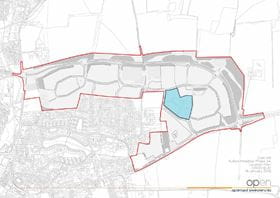The spotlight is on large-scale infrastructure projects and has been for some time. Crossrail is soon to succeed in its aim of transporting people across Central London. As such, investment is already being ploughed into the potential development projects associated with the delivery of HS1 and HS2. However, are we really getting the most out of the £150bn currently scheduled to be invested?
Robert Smith, partner at Carter Jonas, comments “If we are to capitalise on the real value of major new infrastructure projects, we need a strategic approach. We must ensure the billions spent on new infrastructure enables regeneration/redevelopment across the whole of the UK. If the creation of value is the key driver for investment to take place, infrastructure projects could be confined to areas of high value only, causing an increase in the divide between affluent and poorer areas.” If the required strategic thinking prevails, there are many opportunities on the horizon. For example the East West Rail link, also known as the ‘Varsity Line’. “This has to be one of the most exciting new infrastructure projects, linking two of the UK’s economic powerhouses which are currently both restrained by Green Belt policies. This investment will not only provide better linkages between the two cities but a number of sustainable new settlements along the route.” In the case of HS1 and HS2, Smith says, “The regenerative benefits are already being reaped before the first train has even departed. It is a refreshing change to visit Birmingham or Sheffield and find a reinvigorated neighbourhood in place of the chaos of a building site, the benefits of which stretch substantially beyond the transport hub itself.” But is a lack of strategic thinking the only limitation currently placed on the UK’s future infrastructure projects? “No”, says Smith, “our industry needs to adopt an approach to largescale development which is not fettered by traditional thinking - less cyclical and more progressive.”
“Take Crossrail for example, at the feasibility stage they sought to explore the regenerative effects of new and redeveloped stations, including the impact further afield. For example, on the outskirts of the M25 and beyond. But will the scheme have this extensive benefit once it is operational? My concern is that as a country we are simply not bold enough when it comes to maximising the value of major new infrastructure projects. Often our industry needs to be more creative. So what could Crossrail have done differently? “A more radical approach would have been to entirely re-think the street level between Bond Street and the increasingly tired eastern end of Oxford Street, to level it to the ground and create a ‘mini Manhattan’ which would have potentially generated significantly more investment and opportunities for regeneration and development.
“Admittedly, daring strategies are difficult in restrained, urban locations where listed buildings or landmark viewing corridors restrict new development.” So could a more strategic approach to infrastructure help address the current housing crisis? There is an irony, Smith explains, in the fact that while transport infrastructure is not always linked to plans for development, in reality new developments often struggle to succeed because of a lack of infrastructure. “Just as the value of a housing scheme is multiplied with the benefit of good infrastructure, it can also attract huge investment if the wider environment is taken into account at conception.”
“However, we’re heading in the right direction”, says Smith. “There is a new breed of ‘master-developers’ looking to capitalise on the investment in major infrastructure as a core component of some significant new housing led developments. And we are also seeing a more strategic, long term approach from Government, the new Ministry of Housing, the National Infrastructure Commission (NIC) and Homes England. But we need to realise our weaknesses and address them with further joined up thinking. Does the Ministry of Deference sit down with the Ministry of Housing, Communities & Local Government to jointly determine how they could resolve many social and logistical problems together? And where does the NIC fit in? There will always be a balance to be struck between capitalising on planned infrastructure and providing infrastructure to deliver regeneration. But, as always, there is room for improvement and with more strategic thinking, the UK can capitalise on this rather than lose the potential value of major new infrastructure. If as a country if we can be bolder, then perhaps the substantial investment in major new infrastructure projects can be a genuine route to regeneration for the whole of the UK.
This article was first published in Planning and Development Insite click here to download the issue
Robert Smith
Partner, Strategic Land
020 7016 0734
robert.smith@carterjonas.co.uk



 Following a competitive tender, CALA Homes acquired the 9.65 acre site and will be developing 174 homes at Phase 2a, Fuller’s Meadow, which is located south of the new community hub with the new primary school and neighbourhood centre.
Following a competitive tender, CALA Homes acquired the 9.65 acre site and will be developing 174 homes at Phase 2a, Fuller’s Meadow, which is located south of the new community hub with the new primary school and neighbourhood centre. The sale marks the next residential phase of the new community; the first two phases, totalling some 150 homes, are being developed by St. Modwen’s award-winning housebuilding business St. Modwen Homes, which started on site this year. The first occupiers are expected to move in this month.
The sale marks the next residential phase of the new community; the first two phases, totalling some 150 homes, are being developed by St. Modwen’s award-winning housebuilding business St. Modwen Homes, which started on site this year. The first occupiers are expected to move in this month.






